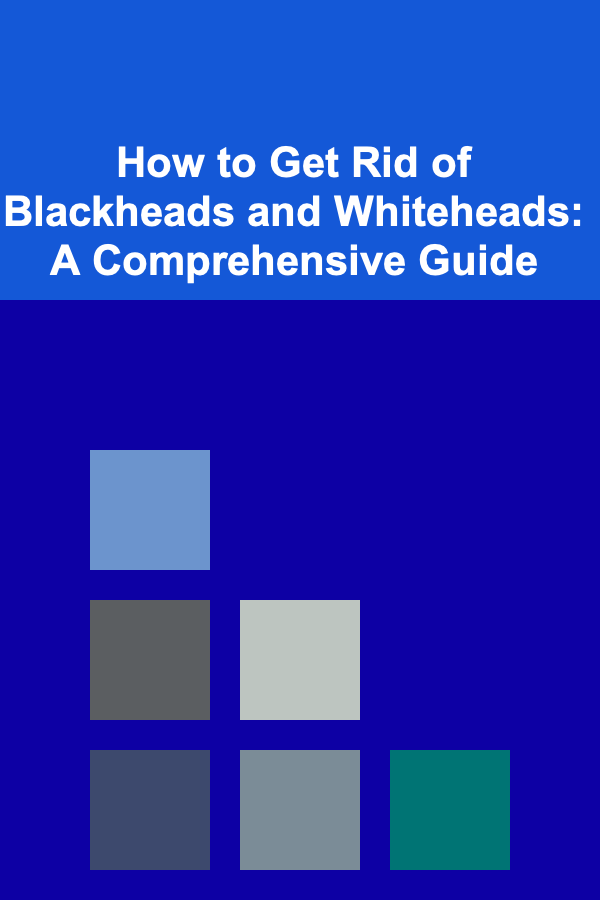
How to Get Rid of Blackheads and Whiteheads: A Comprehensive Guide
ebook include PDF & Audio bundle (Micro Guide)
$12.99$10.99
Limited Time Offer! Order within the next:

Understanding the Enemy: Blackheads and Whiteheads Defined
Blackheads and whiteheads are common forms of acne, technically classified as comedones. They both arise from the same underlying issue: clogged hair follicles. A hair follicle contains a hair and sebaceous glands, which produce sebum, an oily substance designed to keep skin moisturized. When dead skin cells and sebum accumulate within the follicle, they form a plug. The difference between a blackhead and a whitehead lies in whether this plug is exposed to air.
Whiteheads (Closed Comedones): These are closed comedones, meaning the plug remains under a thin layer of skin. This gives them a white or flesh-colored appearance, hence the name. Because the pore is closed, the sebum and dead skin cells are trapped, preventing oxidation.
Blackheads (Open Comedones): These are open comedones, meaning the plug is exposed to the air. When the sebum and dead skin cells are exposed to oxygen, they undergo oxidation, turning the plug black. The black color is not dirt, as is commonly believed, but rather the result of this chemical reaction.
While both are considered non-inflammatory acne, their presence can be frustrating and contribute to other skin issues. Understanding the formation process is crucial for effectively targeting and preventing them.
The Culprits: What Causes Blackheads and Whiteheads?
Numerous factors contribute to the formation of blackheads and whiteheads. While individual experiences vary, understanding these common culprits can help tailor a preventative and treatment strategy:
- Excess Sebum Production: Overactive sebaceous glands, often triggered by hormonal fluctuations (puberty, menstruation, pregnancy), genetics, or certain medications, produce excessive sebum. This excess oil provides ample material for clogging pores.
- Accumulation of Dead Skin Cells: Our skin naturally sheds dead cells. If this process is too slow or if the dead cells aren't properly removed, they can mix with sebum and clog follicles. Ineffective exfoliation exacerbates this issue.
- Hormonal Fluctuations: Hormones, particularly androgens, stimulate sebum production. During puberty, androgen levels surge, leading to increased oiliness and a higher likelihood of developing comedones. Hormonal changes during menstruation and pregnancy also influence sebum production.
- Cosmetics and Skincare Products: Certain comedogenic (pore-clogging) ingredients in makeup and skincare products can contribute to blackhead and whitehead formation. Heavy creams, oils, and some pigments can trap dead skin cells and sebum.
- Improper Cleansing: Failing to cleanse the skin thoroughly and consistently can allow oil, dirt, and dead skin cells to accumulate, increasing the risk of clogged pores. Skipping face washing before bed is a common mistake.
- Diet: While the direct link between diet and acne is still being researched, some studies suggest that a diet high in refined carbohydrates and dairy products may contribute to inflammation and increased sebum production in some individuals.
- Genetics: A predisposition to acne, including blackheads and whiteheads, can be inherited. If your parents or close relatives have a history of acne, you may be more likely to experience it as well.
- Irritation and Inflammation: Scratching, picking, or excessively scrubbing the skin can irritate the follicles and increase the likelihood of inflammation, which can contribute to comedone formation. Harsh skincare products can also have this effect.
The Arsenal: Effective Treatments and Prevention Strategies
The fight against blackheads and whiteheads requires a multi-faceted approach, combining preventative measures with targeted treatments. Here's a breakdown of effective strategies:
A. Topical Treatments: Your First Line of Defense
- Salicylic Acid: This beta-hydroxy acid (BHA) is a powerful exfoliant that penetrates into pores to dissolve sebum and dead skin cells. It's available in various forms, including cleansers, toners, and leave-on treatments. Start with a low concentration (0.5-2%) and gradually increase frequency as tolerated to avoid irritation. Salicylic acid is particularly effective for blackheads due to its ability to exfoliate within the pore itself.
- Benzoyl Peroxide: Primarily used for inflammatory acne (pimples), benzoyl peroxide can also help prevent blackheads and whiteheads by killing bacteria that contribute to pore clogging and reducing inflammation. Start with a low concentration (2.5%) and use it sparingly, as it can be drying and irritating. Consider using it as a spot treatment.
- Retinoids (Retinol, Tretinoin, Adapalene): These vitamin A derivatives are powerful exfoliants that increase cell turnover and prevent pores from becoming clogged. They also have anti-aging benefits. Retinoids can be irritating, so start slowly (once or twice a week) and gradually increase frequency as your skin tolerates it. Always use sunscreen during the day, as retinoids can make your skin more sensitive to the sun. Over-the-counter retinol products are generally less potent than prescription retinoids like tretinoin (Retin-A) and adapalene (Differin).
- Azelaic Acid: This dicarboxylic acid has anti-inflammatory, antibacterial, and keratolytic (exfoliating) properties. It helps to unclog pores, reduce redness, and even out skin tone. Azelaic acid is generally well-tolerated, even by those with sensitive skin. It's available in both over-the-counter and prescription formulations.
- Alpha Hydroxy Acids (AHAs) - Glycolic Acid, Lactic Acid: AHAs are water-soluble exfoliants that work on the surface of the skin to remove dead skin cells. While they don't penetrate pores as deeply as BHAs, they can still help to prevent clogged pores and improve skin texture. They are more suitable for whiteheads and superficial blackheads.
B. Cleansing and Exfoliation: The Foundation of Clear Skin
- Gentle Cleansing: Wash your face twice daily (morning and night) with a gentle, non-comedogenic cleanser. Avoid harsh soaps or scrubs that can irritate the skin and worsen the problem. Look for cleansers with salicylic acid or glycolic acid for added exfoliation.
- Regular Exfoliation: Exfoliating removes dead skin cells that can clog pores.
- Chemical Exfoliation: Using products containing AHAs or BHAs (as mentioned above) is a gentle and effective way to exfoliate regularly.
- Physical Exfoliation: Using a gentle scrub, exfoliating brush, or washcloth can also help to remove dead skin cells. However, be careful not to over-exfoliate, as this can irritate the skin. Limit physical exfoliation to 1-2 times per week and avoid harsh scrubbing. Consider using a soft konjac sponge.
C. Extraction: When To and Not To DIY
While tempting, extracting blackheads and whiteheads at home should be approached with caution. Improper extraction can lead to inflammation, scarring, and infection. If you choose to extract, follow these guidelines:
- Preparation is Key: Soften the skin by taking a warm shower or applying a warm compress to the affected area for 5-10 minutes. This will help to loosen the sebum and make extraction easier.
- Use a Clean Extraction Tool: Invest in a comedone extractor with a small loop at the end. Sterilize the tool with rubbing alcohol before and after each use.
- Gentle Pressure: Position the loop over the blackhead or whitehead and apply gentle, even pressure. Avoid squeezing or forcing the extraction, as this can damage the skin. If the comedone doesn't come out easily, stop and try again another day.
- Post-Extraction Care: After extraction, apply an antiseptic or a spot treatment containing salicylic acid or benzoyl peroxide to prevent infection.
- When to See a Professional: For stubborn or deep-seated blackheads and whiteheads, it's best to see a dermatologist or esthetician for professional extraction. They have the training and tools to extract comedones safely and effectively.
D. Lifestyle Adjustments: Supporting Your Skincare Routine
- Non-Comedogenic Products: Choose makeup and skincare products that are labeled "non-comedogenic" or "oil-free." This means they are less likely to clog pores. Pay close attention to ingredient lists and avoid products containing known comedogenic ingredients like mineral oil, isopropyl myristate, and lanolin (in some individuals).
- Clean Makeup Brushes Regularly: Dirty makeup brushes can harbor bacteria and contribute to clogged pores. Wash your brushes at least once a week with a gentle soap or brush cleanser.
- Avoid Touching Your Face: Touching your face throughout the day can transfer dirt and oil to your skin, increasing the risk of clogged pores. Be mindful of this habit and try to avoid it.
- Healthy Diet: While the link between diet and acne is still being researched, eating a healthy diet rich in fruits, vegetables, and whole grains can support overall skin health. Limit your intake of processed foods, sugary drinks, and excessive dairy.
- Stay Hydrated: Drinking plenty of water helps to keep your skin hydrated and can improve its overall appearance.
- Manage Stress: Stress can trigger hormonal fluctuations that can contribute to acne. Find healthy ways to manage stress, such as exercise, yoga, or meditation.
- Proper Sun Protection: Sun damage can thicken the skin and make pores appear larger. Use a broad-spectrum sunscreen with an SPF of 30 or higher every day, even on cloudy days. Choose an oil-free, non-comedogenic sunscreen formula.
Debunking Myths and Common Misconceptions
There's a lot of misinformation circulating about blackheads and whiteheads. Here are some common myths debunked:
- Myth: Blackheads are caused by dirt. Fact: The black color is due to oxidation of sebum and dead skin cells, not dirt.
- Myth: Squeezing blackheads is the best way to get rid of them. Fact: Improper squeezing can lead to inflammation, scarring, and infection.
- Myth: Blackheads and whiteheads are only a problem for teenagers. Fact: People of all ages can experience blackheads and whiteheads.
- Myth: Tanning helps to clear up acne. Fact: Tanning can actually worsen acne by thickening the skin and making pores appear larger. It also causes premature aging and increases the risk of skin cancer.
- Myth: You need harsh products to get rid of blackheads and whiteheads. Fact: Harsh products can irritate the skin and worsen the problem. Gentle, consistent care is more effective.
- Myth: Pores open and close. Fact: Pores don't open and close like doors. They can appear larger or smaller depending on factors like oil buildup and skin elasticity. Steam can soften the contents of the pores, making them easier to clean, but it doesn't "open" them.
When to Seek Professional Help: Consulting a Dermatologist
While many cases of blackheads and whiteheads can be managed with over-the-counter products and lifestyle adjustments, it's important to know when to seek professional help from a dermatologist.
Consider seeing a dermatologist if:
- Your acne is severe and widespread.
- Over-the-counter treatments are not effective.
- You have painful or inflamed acne.
- You are developing scars or hyperpigmentation (dark spots) from acne.
- You have underlying skin conditions, such as rosacea or eczema, that may be contributing to your acne.
- You are pregnant or breastfeeding and need to avoid certain acne treatments.
A dermatologist can provide a personalized treatment plan based on your individual skin type and the severity of your acne. They may prescribe stronger topical or oral medications, perform professional extractions, or recommend other procedures like chemical peels or laser treatments.
Long-Term Management and Prevention
Getting rid of blackheads and whiteheads isn't a one-time fix; it's an ongoing process that requires consistent effort. The key to long-term management is to establish a consistent skincare routine and maintain healthy lifestyle habits.
Here are some tips for preventing future breakouts:
- Stick to your skincare routine: Don't skip cleansing, exfoliating, or applying your topical treatments. Consistency is key.
- Choose the right products: Continue to use non-comedogenic makeup and skincare products.
- Maintain healthy lifestyle habits: Eat a healthy diet, stay hydrated, manage stress, and get enough sleep.
- Be patient: It takes time to see results. Don't get discouraged if you don't see improvement immediately.
- Adjust your routine as needed: Your skin's needs may change over time. Adjust your skincare routine accordingly.
- Don't pick or squeeze: Resist the urge to pick or squeeze blackheads and whiteheads. This can lead to inflammation, scarring, and infection.
By following these tips, you can effectively manage blackheads and whiteheads and achieve clearer, healthier skin.
Disclaimer: This information is intended for general knowledge and informational purposes only, and does not constitute medical advice. It is essential to consult with a qualified healthcare professional or dermatologist for any health concerns or before making any decisions related to your health or treatment. The effectiveness of any treatment may vary depending on individual circumstances.

How to Build a Checklist for Writing a Resume for Executive or Leadership Positions
Read More
How to Make Money Online as a Landscape Architect: 10 Actionable Ideas
Read More
The Virtual Assistant's Guide: Mastering Remote Work and Client Management
Read More
Organizing Your Workshop or Garage with Smart Tool Storage
Read More
How To Dive Deep into the World of Jazz Improvisation
Read More10 Tips for Integrating Geographic Data into Your Valuation Tracker
Read MoreOther Products

How to Build a Checklist for Writing a Resume for Executive or Leadership Positions
Read More
How to Make Money Online as a Landscape Architect: 10 Actionable Ideas
Read More
The Virtual Assistant's Guide: Mastering Remote Work and Client Management
Read More
Organizing Your Workshop or Garage with Smart Tool Storage
Read More